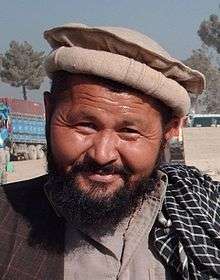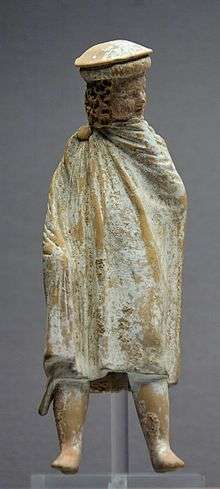Pakol


Pakol (پکول), or the Afghan cap, is a soft, round-topped men's hat, typically of wool and found in any of a variety of earthy colors: brown, black, gray, or ivory, or dyed red using walnut.[1] Before it is put on, it resembles a bag with a round, flat bottom. The wearer rolls up the sides nearly to the top, forming a thick band, which then rests on the head like a beret.
Overview
Pakol's ancestor is perhaps the remarkably similar ancient Macedonian kausia hat, worn by men in ancient Southeast Europe.[2] It gained popularity in Nurestan a few centuries ago. It is now also very commonly worn in Northern and North-Western Pakistan and parts of Kashmir.
The patti is first sewn into the shape of a cylinder, about a foot or more long. One end of the cylinder is capped with a round piece of the same material, slightly wider than the cylinder itself. The woollen cylinder is then inverted and fitted onto a round wooden block. The rim of the woollen cylinder is then rolled up to the top. The flat top protrudes a little over the rolled-up edge to give the cap a tiny brim. Otherwise, all Afghan head wear, unlike Western hats, is brimless. This is because Muslims pray with their heads covered. A brimmed hat would interfere with the sajdah (act of prostration during prayers). The little brim of the pakol, however, presents no such problem.
In Gilgit-Baltistan, the white color pakol is more popular and is sometimes worn with a peacock plume stuck in the folds, like a badge, on the front or the side of the cap. The deep blue and green of the peacock feather, set against the white of the cap, is quite eye catching.
Because of the woolen material, the pakol is basically a cold weather cap. In particularly chilly weather of Nuristan, the cap can be unrolled and pulled down over the ears, like a ski cap. Worn this way, it may look sloppy but is effective against the cold.
The pakol owes its global celebrity to the Tajik-majority members of the Jamiat-e Islami-ye Afghanistan, and in particular to the Shura-e Nezar group with its core Panjshiri mujahedin who, following their leader Ahmad Shah Massud, first adopted it as a standard item of their outfit. Because of this, several authors, some even deeply acquainted with Afghanistan, have sometimes condoned definitions like “Tajik hat” or “Panjshiri hat”. Actually, it could be termed by the same right, “Eastern Pashtun hat” or “Pashai hat”, while labels like “Nuristani hat” or even better, “Chitrali hat”, would come closer to the historical truth. In any case, pakols are now donned by countless tribes and ethnic groups: Hazara, Uzbek, Turkmen, Pamiri, Aimaq – and French, among the rest.[3]
References
- ↑ "Terrorism, power outages hit Chitrali Patti business hard". International The News. October 23, 2010. Retrieved 2015-07-10.
- ↑ Ian Worthington, Nicholas Geoffrey Lemprière Hammond, Ventures into Greek history, p. 135, Clarendon Press, 1994
- ↑ "From Alexander the Great to Ahmad Shah Massoud: A Social History of the Pakol | Afghanistan Analysts Network". www.afghanistan-analysts.org. Retrieved 2016-02-28.
External links
- Willem Vogelsang, 'The Pakol: A distinctive, but apparently not so very old headgear from the Indo-Iranian borderlands'. Khil`a. Journal for Dress and Textiles of the Islamic World, Vol. 2, 2006, pp. 149–155.
| Wikimedia Commons has media related to Pakol. |